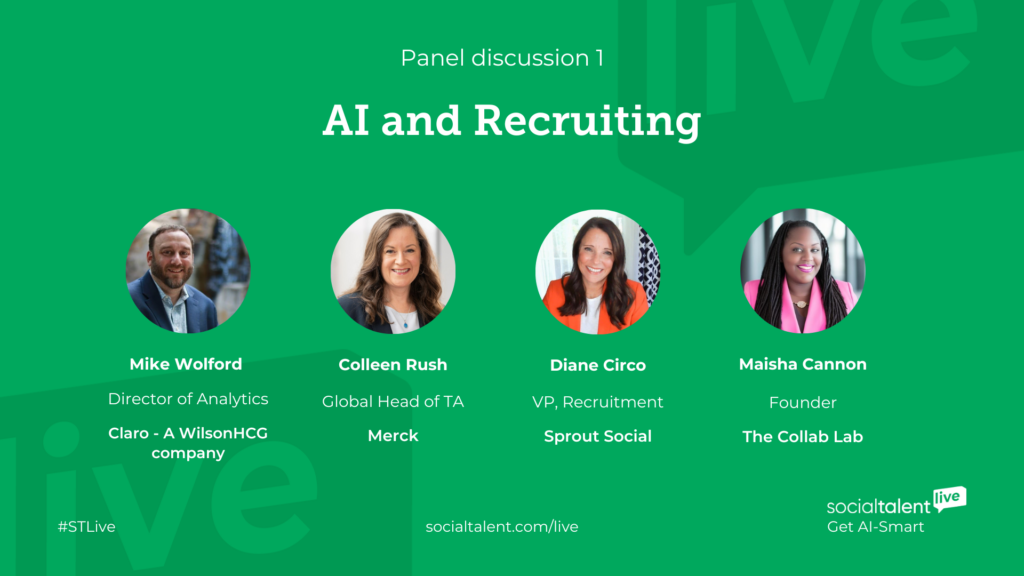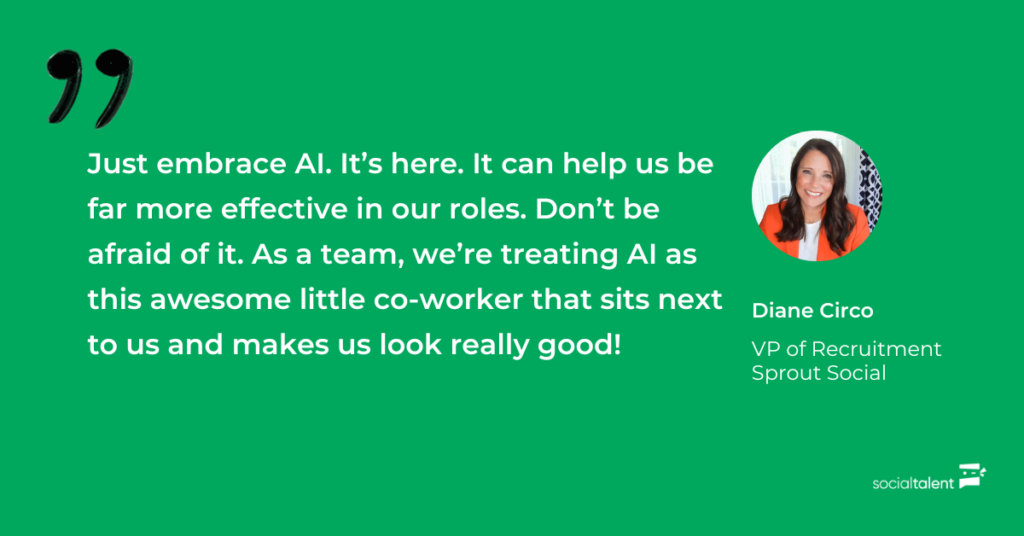
By David Deady
Modern recruitment is ever-changing. Innovation is essential when it comes to transforming and evolving this function, and Artificial Intelligence (AI) seems to be the driving factor right now.
At the heart of this conversation lies a profound question: How is AI redefining the landscape of talent acquisition? Our recent SocialTalent Live webinar provided an illuminating glimpse into a future where AI isn’t just a buzzword but a tangible force for change.
In this blog post, we’ll unpack the key findings from the dedicated panel discussion from the event and explore the various dimensions through which AI is making its indelible mark on the world of recruiting. From turbocharging the speed and reach of hiring processes to elevating candidate experience, AI’s influence is far-reaching and multifaceted.
We’ll also delve into the critical issue of bias in recruitment, uncovering how AI can serve as both a remedy and a potential pitfall in the quest for fairness. Along the way, we’ll be mindful of the cautions and ethical considerations that must accompany AI’s integration into recruiting practices.
Did you miss the event? Catch-up and watch it here!

1. Increasing capacity and speed of hiring
Succinctly put by Mike Wolford, Director of Analytics at Claro, AI has the ability to “give us back more time to be the recruiters we want to be.” There is an understandable unease surrounding AI at the moment, but there is also enormous potential, particularly in the hiring space. So much of a recruiter’s day can be consumed by thankless (but necessary!) admin. AI has the capability to unshackle recruiters from this, allowing more time for more important elements of the job.
Diane Circo, VP of Recruitment at Sprout Social, believes that influencing candidates and relationship building is something only a recruiter can do, and is critical for achieving great hiring outcomes. “Now imagine if we harnessed AI to create more time and space for that,” she tells us, “allowing recruiters to spend more time understanding the needs and motivations of candidates, tailoring engagement to convert prospects into candidates and candidates into great hires.”
2. Improving candidate outreach
Whether it’s a job description, a LinkedIn InMail, a social post, or response email, generative AI can get you a first draft fast! Colleen Rush, Global Head of TA at Merck, mentioned that the quality of the job descriptions she receives from hiring managers tends to be highly variable. The expectation is that the recruiter will then polish this, removing spelling, grammar, readability errors for example. AI can bridge this gap, supporting both recruiter and hiring manager to create and iterate much more efficiently and effectively.
Learn more: 5 Essential ChatGPT Prompts for Recruiters
But there is a word of caution here as well. As Mike Wolford states: “this is a chance for us to get better. Don’t just automate your outreach. Challenge the AI and unleash your creativity.” The first response that ChatGPT delivers should not be your final product. Maisha Cannon, Founder of The Collab Lab, put this into perspective for us perfectly: “We don’t just have the constraints of our own cognitive ability, we now have a thought partner to riff with. Creativity and critical thinking can increase if we are intentional – AI can enrich what we do.”
3. Preparing candidates
Mike called out an area of the recruiting profession that he feels has been somewhat dwindling – candidate prep. What used to be a required step of the process is now often overlooked, but AI can reinvigorate this important step. By feeding GPT4 with resume and job description details, Mike was able to create a custom interview prep guide for a candidate in whatever format he needed. Game changing! And Colleen backed this up, stating that AI “gives the opportunity to upgrade the level of information we give candidates, which in turn helps to make better hiring decisions all around.”
And while there has been a lot of chatter about how AI can despersonalize the hiring process, with the right tools and the right intentions, Diane believes that it can in fact “accelerate our ability to create a real consumer grade candidate experience.” By automating certain moments, you leave more space for important human interaction.

4. Caution with AI
When it comes to concerns and challenges relating to these large language model AI systems, the most pressing is that of data protection. Maisha explained this to our listeners, particularly in relation to uploading CVs and personal company data into free AI tools. Most of these are experimental and are using our inputs for training, so extreme caution is required. However, Maisha is also encouraged by the release of enterprise level versions of generative AI systems – these will afford companies much more stringent levels of security and protection. But for now, the advice is to proceed with caution. Aside from this, there is also a fear of oversaturation of sameness, that without a concerted effort to improve upon and iterate responses, recruiters could find themselves feeding into spam-type communication which will not be as effective.
5. AI and Bias
Bias is always a big concern when it comes to AI. But given that this tech is in its nascent stages of development and usage, it’s important to recognize that AI won’t be perfect and needs time and effort to improve. According to Diane, most companies can do a lot to mitigate this bias by being very intentional and the tools they use and how they choose to use them. Always verify that the vendor is using responsible and explainable AI, and is transparent with how it programs and develops algorithms. “What gives me hope,” Diane says, “is that bias in AI can be detected, addressed, and fixed. This is much harder to achieve with humans. We can train AI to ignore the things that create bias like education and gender, for example.”
Conclusion
Recruitment is undergoing a remarkable transformation, and at the forefront of this change stands the game-changing force of Artificial Intelligence. Our recent exploration of AI’s impact on talent acquisition through the SocialTalent Live webinar has illuminated a future where AI transcends mere fantasy to become a tangible catalyst for positive change. With proper guidance and ethical considerations, AI can redefine recruitment, making it more efficient, fair, and ultimately more successful.


